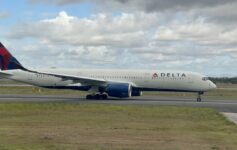Airlines from the busiest markets in the world have stated that there was too much capacity on the market, but that masks a bigger problem – bad for investors and flyers alike.
If you are considering booking travel or signing up for a new credit card please click here. Both support LiveAndLetsFly.com.
If you haven’t followed us on Facebook or Instagram, add us today.
Airlines Are Repeating The Same Mantra – Too Much Capacity
Over the last couple of months, airlines in the busiest markets in the world have revised their earnings projections mid-quarter to reflect “too much capacity” on the market. In essence, revenge travel coupled with inflated prices kept going, and growing well after most economists suspected it would end. Some quarter, which appears to have been Q2 2024, it had too be too much and it was.
There’s no sin in trying to capture all of the available market, and no one knows the future. But what does too much capacity really mean? It’s another way of saying, not enough customers. Kind of. As this site pointed out in prior weeks, the US (the busiest air market in the world) has set several records in the second quarter and early into the third quarter for passengers passing through US security checkpoints. Adding more capacity allows both record passenger numbers and excess seats at the same time. That’s easy to fix as long as that’s the case. But what happens if excess capacity isn’t the reason for the decline?
The carriers are in lockstep on the capacity note, but that doesn’t mean they are telling the full story.
The Problem With The Capacity Theory
If there’s too much capacity on the market the solution is simple and quick. Reducing capacity is not an impossible market force. The easiest way to start is by reducing frequencies between hubs and major leisure routes. Then we move on to downguaging aircraft from 737-900s down to 737-800s or 700s, from A321s down to A320s or A319s, from 777s to 767s – all of these subject to the range limitations of the aircraft.
It’s true that airlines can’t take flights entirely off the schedule in some cases where they’ve sold tickets for the future and offer limited frequency, but correcting a small capacity problem in the range of 5-6% as most carriers have indicated, is far from impossible.
That’s where this excuse falls apart.
The explanation in board rooms with investors could be, “everyone in the industry kept the growth streak going and we didn’t want to be left with full planes and unrealized potential. Everyone found out the market limit in the same quarter at the same time and we have dialed back our capacity growth measures to align with the market.”
Excess capacity can be overcome by reducing that capacity or by lowering prices to drive demand (unless your Scott Kirby and don’t believe in elastic demand.) There’s no reason to forecast anything besides a gentle recovery in Q3. But airlines haven’t been doing that. Lufthansa, for example, has gone from matching last year’s €2+bn in profit to looking at breaking even.
Shareholders Will Lose
Having too much capacity is the same as having not enough customers. The problem is they both look the same right now. If a restaurant adds a bunch of seats to the patio and buys too much food, it will take a loss and can pull the chairs back off the patio. But that’s a different problem to solve than fewer customers coming through the doors. They have different remedies.
Shareholders lose when management isn’t honest about the problems it faces. It’s clear the consumer wind is turning, if not (nearly) every airline would have revised down its earnings for the quarter, not the year. Lufthansa was on pace to match earnings from last year, around €2.2bn, now it hopes to break even for the year.
“Lufthansa Group lowered its outlook for the year, saying that its flagship carrier is struggling to break even. It cited negative market trends and aircraft delivery delays for the shift.
The company, which also includes Austrian Airlines, Brussels Airlines, Eurowings and Swiss, expects its adjusted earnings before interest to fall in the range of €1.4 to €1.8 billion ($1.52 billion to $1.96 billion), down from its previous guidance of €2.2 billion ($2.4 billion).” – Skift
There are too many solutions for 5% excess capacity that don’t involve that level of revision. JetBlue is offering LOAs to staff members (voluntary “Leave of Absence”) and has cut its schedule by 10%. It appears to be taking the “capacity” issues much more seriously.
Consumers Are Not Inelastic
The biggest issue with not calling this what it is – an economic slowdown in discretionary spending – is what it will lead travel suppliers to do. While some carriers have reported price deterioration, others will claim that’s not necessary. Afterall it was simply an over exuberance in supply, not a shift in consumer appetite.
That means the goal will be to keep prices elevated. United Airlines CEO Scott Kirby all but said this as Matthew pointed out. Kirby learned that consumer demand was inelastic, that dropping prices won’t move the needle, and if that’s the case, why do it? Matthew and I agree that this is absurdity at its finest. He gave an example of opting for a virtual meeting rather than paying $1,400 for a domestic first class seat from LAX to Pittsburgh. I remember taking mileage runs to Hong Kong in business class for not much more than that just a few short years ago.
And that’s the point.
I have no plans of going to Barcelona next week, but if I found roundtrip deals in business class for $1,200 my family and I are clearing our schedules and packing our bags. At $5,000 per person, it’s a hard pass. The same goes for my business trips. If it’s crucial to my business, yes, Kirby is right, that specific business demand is inelastic. But the pandemic forced every professional to use video conferencing software and it’s a far easier and cheaper crutch than choosing to spend exorbinant sums for trips that aren’t truly imperative.
That all seems logical, but what does proving consumers are price sensitive and that demand is elastic have to do with any of the rest of this?
By blaming the issue of filling seats solely on too many seats on the market it solves for the wrong problem. The way to solve that is to remove the seats from the market. But that means that the current nosebleed prices remain.
That’s bad for consumers in the short term and the long term.
If airlines are less likely to adjust prices to meet demand and rather adjust supply instead, I fear it could leave travel out of reach for some just when we’ve experienced peak travelers. It means that airlines may be more likely to reduce service and options than compete on price and carry more passengers and that’s not an exciting future for avid flyers.
Conclusion
Airlines are all giving the same answer: too much market capacity. But the forward reaction to earnings across the board tells another story. They see lower demand beyond the capacity fixes they can make but refuse to call it anything other than a capacity concern. It seems to suggest that while some have mentioned the market “softening”, they may be intent on holding prices higher for longer and making cuts to fares more shallow than in the past. This will result in fewer choices going forward for more money.
If management truly doesn’t see the writing on the wall, responses will be worse than higher prices. In a business with razor thin margins that could mean that newly inked deals for flight attendants and pilots could see more LOAs or worse.
What do you think?




This is a classic oligopolistic competition with either Cournot (quantities aka “capacity”) vs Bertrand competition (competiting on price). Price competition will lead to zero profits so Kirby wants the industry to focus on competing on capacity which allows for a Nash equilibrium of supranormal profits. Time will tell
Speaking of “Capacity” , the two ‘Lettuce Heads’ , Jill and Joe , have Zero capacity between them .
You make no mention of steadily rising costs from rich pilot agreements and other labor groups, along with rising airport facility costs such as JetBlue retreating from use of a very expensive JFK T6, DFW Terminal F, Newark Terminal A which are one or two billion each, Costs are rising which forces fares up to cover it hence reducing demand. I’m also surprised that Boeing’s travails which has led to significant shortfalls in deliveries of 737s and 787s which would decelerate capacity growth. There is a lot more than a capacity issue going on.
@Rhys: Many of the airport projects are covered in part or in whole by the Infrastructure Bill (2021, I think) though I know airlines are investing some in these too. In the linked articles, (and in this one) I talk about inflation too. The Boeing (and Airbus) delivery issues have also been covered in prior articles including the linked one to the Lufthansa piece.
Here’s a post from April 2023 where I talk about the pilot contract and called out then that the exorbinant costs were based on insatiable demand that could not possibly hold up with the slightest downturn: https://liveandletsfly.com/earnings-reports-suggest-airline-pilot-salary-unsustainable/
I also mentioned this in a few other articles about American Airlines flight attendants seeking higher pay. https://liveandletsfly.com/i-spoke-to-a-veteran-aa-flight-attendant-why-a-strike-is-closer-than-ever/
I was thinking the same, about those lucrative contracts the various labor groups got. It’s going to be interesting to watch how that plays out.
The costs for labor groups do not meet the appropriate level of experience and sustainability for the revenue airline tickets provide.
Why is a pilot flying LAX to SFO for half the month entitled to 300k a year? Filled with 50 dollar tickets?
Like most things in the economy. There are plenty of professions that are paid way more than they should be to be sustainable.
Baristas making as much as 40-50 dollars an hour in America with soliciting tips is just not sustainable or fair for say an EMT paramedic making minimum wage of less than 20 dollars per hour?
Kirby has often espoused some pretty wacky theories to try to somehow justify gouging the flying public. Remember when he said that airfares should remain at a consistent portion of GDP?
An economics professor with whom I work considered the GDP argument ‘left field’, to be polite!
Part of the problem with this overcapacity narrative is the P&W GTF engine issues. Spirit, JetBlue and others who bought 320 family aircraft with the GTF have a ton of airplanes parked at the moment. Airplanes that were being heavily used in the domestic market. If this was just about domestic overcapacity I think the combination of parked aircraft and record pax numbers would have addressed it.
I don’t know what the answer is but one thing I’m certain it’s not is too much capacity domestically.
I’ll be using Scott Kirby and his bizarre statements about elasticity and revenue as a % of GDP as a case study in an economics class I have just started teaching. We don’t get too many laughs in the discussion of supply and demand 🙂